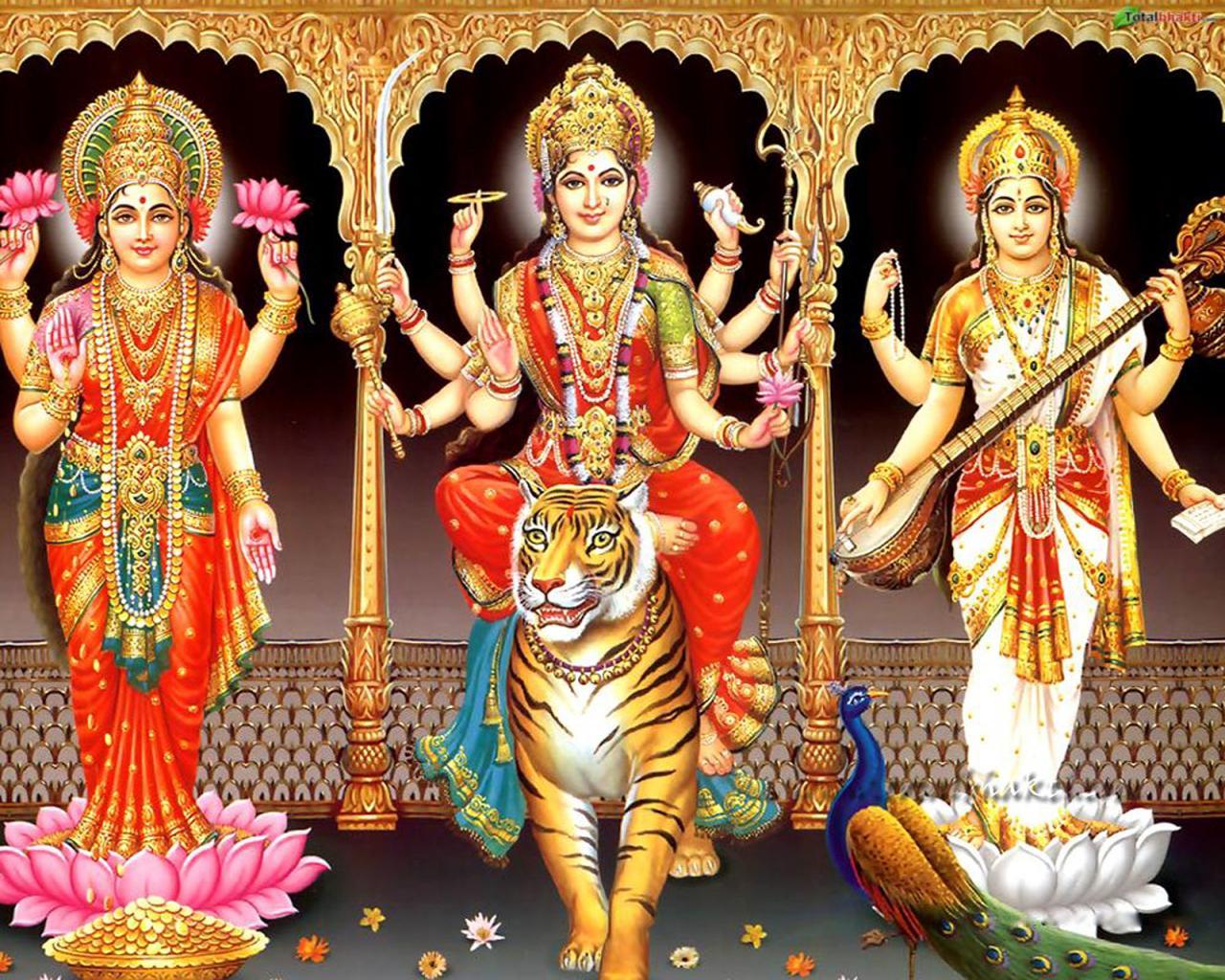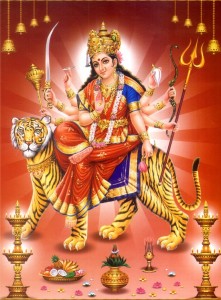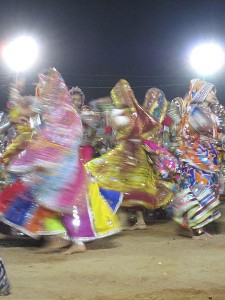NHSF (UK) Learning Team
Navratri Dates: 5th October 2013 – 13th October 2013 (1st Aashwin – 9th Aashwin in the Hindu Calendar)
Navratri is celebrated during the first nine days of the Hindu month Aashwin (September – October). It coincides with the rainy season in India; with new buds and blooms and hence considered by many to be a good time to begin new ventures. The festival is dedicated to the worship of the Divine Mother, also known as Durga or Shakti, which is the supreme power in the maternal form and creates, sustains and withdraws the cosmic order.
Devotees celebrate the victory of Lord’s shakti (power), over evil. Each of the nine nights celebrates the feminine divinity: Durga (Icon of feminine strength) Laxmi (Goddess of Wealth) and Saraswati (Goddess of Knowledge). The first three nights are devoted to the worship of the Goddess of valour, energy and strength, Shakti, and her different avatarams (forms) as Kumari, Parvati and Kali. The next three nights are spent in celebration of Laxmi; Goddess of peace and prosperity, with whose blessings one may gain fulfilment. The final three nights Goddess Saraswati is worshipped with hopes that she might bestow us with the knowledge that may free us from the materialistic wants that bind us to the world.
Origin
Having pleased Brahma, the evil Mahishasur obtained a boon that he should never die by human hands. He then created carnage in the three worlds, worrying the three ‘Devatas’ – Brahma, Vishnu and Shiva. They prayed to the Lord for protection. This resulted in the manifestation of Durga. To vanquish Mahishasur, Indra gifted Durga his weapon, ‘Vajra’. Vishnu gave his ‘Chakra’ (Spinning Disc) and Shiva gave his ‘Trishul’ (Trident). By creating 18 arms, Durga fought for 9 days with Mahishasur, using many of the weapons bestowed to her. On the 10th day, she attained ‘Vijay’ – victory and hence it is known as ‘Vijaya Dashmi.’
The Ram Leela, the story of Lord Ram, is a popular performance at this time as it signifies the victory of goodness over evil. In the battle of Rama and Ravana, which is believed to have raged for the nine days of ‘Navratri’, Lord Rama’s victory occurred on the tenth day. The tenth and final day of the Navratri ‘Dushera’ or ‘Vijaya Dashmi’, which translates as the day of victory, is grandly celebrated and often giant effigies of Lord Ram’s enemies Kumbhkaran, Meghnad and Ravana are burnt in public.
Celebrations
The festivities vary in their style across India.
In the North, devotees fast for the nine days and worship the different forms of Goddess Parvati each day with yagnas or havans and the recitation of scriptures. In Eastern India murtis of the Goddess are adorned and worshipped for the period of nine days and immersed in water on the tenth day; the Durga celebrations are particularly popular amongst Bengalis.
Gujarati devotees celebrate with extra pomp and style as communities come together for public performances of Garba or Dandiya-Raas, a tradition which most Gujarati devotees outside India still follow today.
In the South, girls and mothers create “Golus & qout’’ (decorated dolls) which they display in their home, with murtis of God, toys and other auspicious statues; conducting artis and archanas for the Goddess Durga. In Andhra Pradesh and Karnatka, gifts are exchanged and various scenes from the great epics are enacted.
Durga Mata
Although there is much variation in the celebration of this festival over India, the common factor is the worship of the Divine Mother, Durga. The Sanskrit translation of her name is ‘She who is incomprehensible or difficult to reach’ and denotes the struggle in attaining the righteous moral order that she represents and protects.
Her red clothing symbolises action: destruction of evil and protection of good. Her tiger represents her limitless power and the many weapons convey that where different enemies are present, different weapons are required to destroy them, e.g. hate by love, desire by detachment and ego by self-knowledge.
The following are some of the common names of Goddess Durga: Maheswari, Kaumari, Varahi, Vaishnavi, Chamundi, Kali, Bhuvaneswari, Mathangi, Lalitha, Annapurani and Amba.
Importance
The most significant aspect of Navaratri is to please Shakti-Mataji. Just as Parvati performed austerities for 80,000 years to please Shiva, women fast for 9 days in their own way. Some have only one meal a day, others only milk or fruit. This self-control, known as ‘sanyam’, has the Shakti (power) which pleases Mataji.
After marriage, a man becomes a ‘Pati’ (husband) a woman, ‘Patni’ (wife). However, when the ‘Pati’ becomes a ‘Pita’ (father) and the ‘Patni’, a ‘Mata’ (mother), then Hindu Dharma upgrades them to the level of deities (‘devatulya’), hence:
“Pitru devo bhava, Matru devo bhava”
“Revere your mother as God, Revere your father as God”
Taittriya Upanishad
For females, the emphasis is to imbibe attributes of a true Mata, as exemplified by Shakti. Therefore during Navaratri, Shakti is offered worship precisely to earn her grace and so continue a sacred tradition rather than desecrate it. For this, the father and mother have to vanquish evil instincts or thoughts which may have crept into the heart during the past year. This increases one’s Shakti. In turn, this endeavour is boosted by Shakti-Mataji, who vanquishes the evil elements within and showers her grace on devotees who have offered pure worship.



